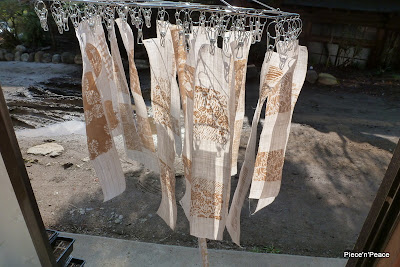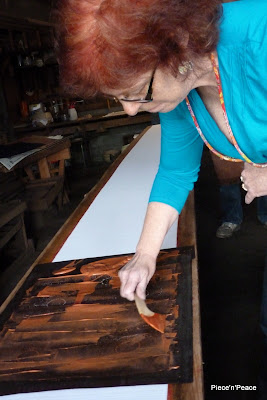This post is about one of the most memorable and amazing days of the whole tour, almost a religious experience, the day we went to visit the Indigo Master.
My Indigo Sister, Blandina has written beautifully about our visit to Noguchi san on the Japanese Textile Study Tour here and our Sensei, Bryan has posted here. Bryan is currently exploring the origins of katazome dyeing on his blog. In those posts you will find a lot of detail, technique and explanation whereas I feel my post is about to become very emotional and subjective.
Our learning about katazome, about persimmon paper and stencil cutting began late one night after a visit to the onsen and then a great pizza meal cooked especially for us by Tohei. It was probably the last thing I wanted to do (my bed was calling) but Bryan was determined that we should have some understanding of the process before our visit to Noguchi san's katazome studio the following day. We also needed to prepare stencilled fabric to dye.
He was right of course, when Noguchi san and his son,
Kaz (the eight generation of stencil dyers there), welcomed us and started to describe and demonstrate their craft it was helpful to have had the introduction from Bryan, so many new terms, new processes and important stages.
I feel sure that the workshop had been especially tidied for our visit, it was wonderful and much appreciated.
So many delicious nooks and crannies, seasoned and loved tools, a feeling of being in a completely different time and place from the Tokyo we'd left at the door of the studio, as we stepped down onto the hard earth floor.
We were able to dye our prepared stencilled pieces in the fermented indigo vats and then Noguchi san washed them four times for us, removing all remnants of paste and sawdust.
They then dried in the sunshine.
Kaz demonstrated his skill under the watchful eye of his father, if he was nervous it didn't show.We were all incredibly privileged to be allowed to use the wonderful stencil to print a whole kimono length as we'd seen Kaz do (well, in a similar but far less skilful and confident way) and it was shared out so that we could dye our own piece.
Whole kimono lengths are taken outside still on their boards and dried in the fresh air before dyeing. (The photo above shows Kaz taking our length out to dry, with gaps between each section of stencilling so that there were no arguments).
A kimono would be placed on "tenterhooks" to hold each section separate from the next while it was in the indigo vat. Noguchi san showed us some wonderful examples of his work. He prints the kimono lengths on both sides, the pattern matched up perfectly. The resulting yukata (summer kimono) sell in the best department stores for very high prices.
Noguchi san also modelled a stunning fireman's jacket for us
We looked at some used stencils (and Bryan valiantly tried to persuade Noguchi san to sell some to us), they are incredible works of art and skill in their own right.
No luck on the stencils but Bryan did negotiate the purchase of some of the kimono lengths.
Expensive still (but not considering the skill involved) but what an opportunity, what a souvenir, how impossible would it be to cut? Nat and I agreed to share a length so we had to cut it before either of us could leave Japan but any further cuts will be very carefully considered.
We drank green tea and ate a 'picnic' lunch in the workshop, admiring the glorious simplicity in which the indigo master and his family lived, a timewarp, a hidden world, we were running out of suitable language to sum up our experiences and we were incredibly grateful to Bryan whose slowly burning seventeen year master/respectful student relationship with Noguchi san had allowed us to make this visit.
Want more?
From Bryan's blog:
So this picture just about sums up my feelings in launching this
workshop and inviting you to look inside. It was taken during the spring
workshop as I was explaining the complexities of Noguchi san's indigo
unique fermentation technique.
The lid is open. What is inside is very valuable and interesting and has
great potential for all the indigo sisters. (No indigo brothers last
time.) It was up to me to explain it as simply and clearly as I could.
With a deep breath, enthusiasm and hope, I ask you to take a look at
the Autumn 2012 brochure. file:///Users/bryanwhitehead/Desktop/docs.google.com:.webloc




































Great sequencing of the photos, Lis. There was a certain reverence that permeated that day. We were all both awed and respectful of the skill shown by master and fascinated by the complex process of the stenciling and dyeing.It was a memorable day.
ReplyDeleteI love all your pictures. I've been to several dying places but that was the most neat and organized I've ever seen. Thanks for sharing so much of your trip.
ReplyDeleteWhat an amazing experience, thanks for showing us all the photos
ReplyDeleteIt is nice to watch your pictures and discover details that I didn't get at the time. It was a special day indeed, a jump into a different world.
ReplyDeleteLike you, 'after Japan' I am more conscious about beauty,and sometimes I am surprised at what is in my stash!
It was a great day. I treasure our piece of katazome double print too. I'm glad you did the choosing because I couldn't have done it. Too many to choose from.
ReplyDeleteIt is easy to see this was the highlight of your trip. Most interesting as your photos are so clear and attractive. After seeing all the work that goes into a piece of fabric there is no wonder we are willing to pay a lot of money for a little piece of 'boro' at the flea market.
ReplyDeletewhat a day! and such wonderful memories. that was the day I lost my camera so seeing your photos is a treasure. love your new header.
ReplyDeleteHey Lis! It was so great reading your blog post about the tour. Hope you had a great time, it looked and sounded like an unforgettable trip!
ReplyDelete